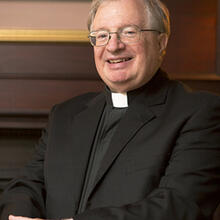On Friday evenings in the early 1950’s, after the dinner dishes had been washed, dried and put away, our family would be joined by our friends and neighbors, the Scaras, in front of our 12-inch Crosley console to watch a couple of hours of television. The first program of the evening, and my favorite as a young boy, was “I Remember Mama,” a series about a Norwegian immigrant family in early 20th-century San Francisco. No doubt, the fact that the Hansens were a Norwegian-American family had a certain appeal for us; but, in memory at least, the series was just good family drama unlike the steady diet of “reality” programming and procedural crime routines broadcast today. One episode we looked forward to each year was the Christmas story.
The Christmas broadcast focused on a Norwegian folk legend, told to the children by their father, Lars, that on Christmas night the animals could be heard to speak. The plotline, of course, focused on the children’s efforts, especially those of the youngest, Dagmar, to hide in the barnyard to hear the animals speak at midnight. The episode, like numerous folk ties to Christmas, linked the animal kingdom to the birth of the Messiah.
Today all that seems to remain of cultural memories like the Hansens’ folk tale are the figurines in our crèche sets and the images of the nativity on our Christmas cards. But for the better part of two millennia, the tie between animals and Jesus’ birth was as natural to our ancestors as e-mail is to us. If you visit Shepherds’ Field, the holy site the Franciscans maintain just outside Bethlehem, your friar guide will explain how shepherds would warm themselves by placing their flock at a cave’s opening and then building a fire within. Until a few years ago, Bedouin herders could still be found making their homes in the caves of the Judaean wilderness, not far from Bethlehem. When St. Francis of Assisi organized the first, living crèche at Greccio in 1223, he took advantage of the same pastoral customs, bequeathing to us the tradition of sheep, donkeys and oxen resting alongside the manger.
It was the same Francis who celebrated his kinship with all creatures in his famous Canticle of Creation. His legend is replete with stories of his interaction with animals, what I once called “interspecies encounters,” preaching to birds and pacifying the wolf of Gubbio. Thomas of Celano reported, in the first written life of the saint, that Francis “carefully exhorted all birds, all animals, all reptiles, and also all insensible creatures, to praise and love the Creator....” Francis, Celano wrote, possessed “the most gentle feeling of devotion to all things,” and “called all creatures his brothers and sisters, like one who had arrived at the glorious freedom of the children of God.”
Devout Christians sometimes dismiss the popularity of Francis statues among gardeners, and they deplore the success of the blessing of animals on his feast day with sentimental folks who fall short of conventional standards of piety. Even Lawrence S. Cunningham, one of the country’s leading interpreters of sainthood and an expert on Francis, objects that the sentimental Francis of popular imagination is a result of 19th-century romanticism. Cunningham is correct in asserting that Francis’ love of creation is consistent with the Catholic affirmation of the goodness of the material world; but Leonardo Boff is closer to the mark, I believe, in interpreting Francis’ encounters with animals as a result of a gentleness that grew out his transforming identification with Christ. Far from being romantic sentimentality, Francis’ kinship with creation was the result of his radical conversion and embrace of Lady Poverty. It followed, in Boff’s words, “a long and demanding novitiate,” in which he embraced lepers and served the poor.
When we kneel at the crèche, as Maryann Cusimano Love encouraged us to do in her column last week, we must, in the spirit of Francis, examine our love and service of the poor. As we contemplate the scene, placing ourselves among the animals warming the manger, we likewise need to consider our kinship with all God’s creatures. Jesus, after all, is the lord of all creation; and the Incarnation is a crowning blessing for the entire cosmos.
So Christmas is an appropriate time for all of us to evaluate how, like Francis, we can take on Christ in guarding God’s creation. Faced with global warming, species extinction and acidification of the oceans, we can do much both to reform our destructive lifestyles and to stir ourselves to acts of courage and imagination to enhance Earth’s future. In doing so, we will help realize Isaiah’s vision of the peaceable kingdom, where the wolf lies down with the lamb and the child plays unharmed alongside the viper’s nest.







